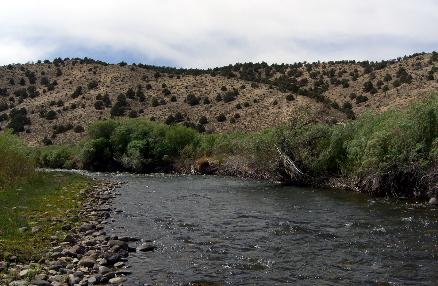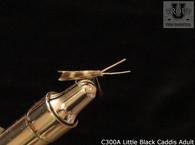
The East Walker River is a tributary of the Walker River in eastern California and western Nevada. It is some 90 miles long and drains the eastern side of the Sierra Nevada. It is a tailwater flowing along Highway #182 from the Bridgeport Reservoir into Walker Lake in Nevada. Along the way, it is joined by the West Walker.The main water supply for the East Walker is from the snow melt in the Sierras which provides exceptionally clear water above the lake. The Reservoir is relatively shallow consisting of warmer water which helps the trout as well as baitfish to grow rapidly...good for us.
The East Walker River is known for its trophy brown trout that can reach as much as 30 inches long, not to mention the large rainbows. A section known for these monsters is the "Miracle Mile which is the first mile of water after leaving the dam at Bridgeport Reservoir. The East Walker has generous populations of aquatic insects as well as a good supply of baitfish making it an anglers dream. The water releases from the dam provide a great year around temperature that is favorable to the midges, blue winged olives and other insects. This habitat makes it a great river for the fly fishermen.
After leaving the "Miracle Mile", the river drops into a canyon where it provides a variety of waters from slow moving to areas with steeper declines providing rapid water. Besides the "Miracle Mile" some of the other well known spots are "Murphy's slough, Sceroni Ranch, Rosaschi Ranch and "The Elbow".
The stretch of water in California is designated general trout season which begins with the last Saturday in April and lasts until November 15. In this stretch,only barbless flies may be used, but the trout may be kept. The Nevada section which is at least 8 miles long is strictly catch and release with barbless hooks.
Fly Fishing the East Walker River:
Due to the constantly changing water levels in the river, a number of strategies may be used. The changing water conditions make it a challenge to get the right equipment for all situations, however, the best size would be a 5 weight line. A 6 weight line would give a litle more insurance for the larger browns and would deliver some of the larger streamers or nymphs better. A floating line is suggested, but a sinking tip may also be suited for the streamers. A 9 foot medium to fast rod of 5 weight would probably be best for most conditions. For leaders give yourself several sizes from 1X to 7X and about 7 foot in length. Tippet again should be in the 1X to 7X to cover the spectrum.
Some of the time, dry flies will work best but for the most part, nymphs and streamers will work. In the section where there are meadows, terrestrials may be a good choice in the mid summer. The river has a favorable PH which contributees to algae growth so it is slick at times, but because of the favorable conditions, there are good opportunities for fishing. Again, as with most tailraces, please be aware of the releases from the dam.
Spring:
In March and April the blue winged olives hatch, Caddisflies in April, Pale Morning Duns start in the end of May.
Summer:
June brings the Yellow and the Golden Stoneflies and the spotted Sedges, followed by the Short-horned Sedges and Green Hedges which also start in June and July. They are followed by the start of the Trico hatch in late summer and early fall. Terrestrials, such as beetles, ants and hoppers will also be productive in the summer.
Fall:
Of course the bi-brooded Blue Winged Olives are hatching, as well as some of the Caddisflies and the Tricos. This activity will continue from late August thru September. Baitfish and sculpin imitations will be productive as well especially on the larger trout.
Access is good along the highway even in the canyon. Some of the river is in the hands of private ranchers, and some in the U. S. Forest Service, so be conscious of your surroundings. Also, be polite and respectful of the land owners.
See our East Walker River California - Nevada Hatch Chart for the river's hatch activity.





